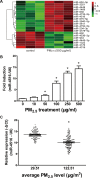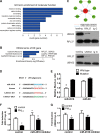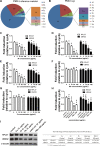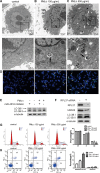Role of microRNA-4516 involved autophagy associated with exposure to fine particulate matter
- PMID: 27329587
- PMCID: PMC5216729
- DOI: 10.18632/oncotarget.9978
Role of microRNA-4516 involved autophagy associated with exposure to fine particulate matter
Abstract
Metals are vital toxic components of fine particulate matter (PM2.5). Cellular responses to exposure to PM2.5 or PM metal components remain unknown. Post-transcriptional profiling and subsequent cell- and individual-based assays implied that the metal ion-binding miR-4516/RPL37/autophagy pathway could play a critical role in cellular responses to PM2.5 and PM metal stresses. miR-4516 was up-regulated in A549 cells exposed to PM2.5 and in the serum of individuals living in a city with moderate air pollution. The expression levels of the miR-4516 target genes, namely, RPL37 and UBA52, were involved in ribosome function and inhibited by exposure to PM2.5 and PM metal components. Autophagy in A549 cells was induced by PM2.5 exposure as a response to decreased RPL37 expression. Moreover, enhanced miR-4516 expression was positively correlated with the augmentation of the internal burden of aluminum and lead in individuals living in a city with moderate air pollution. Hereby, the miR-4516/RPL37/autophagy pathway may represent a novel mechanism that mediates responses to PM metal components.
Keywords: PM2.5; autophagy; metal; microRNA; ribosome.
Conflict of interest statement
The authors declare no competing financial interests.
Figures






Similar articles
-
MicroRNA-1228(*) inhibit apoptosis in A549 cells exposed to fine particulate matter.Environ Sci Pollut Res Int. 2016 May;23(10):10103-13. doi: 10.1007/s11356-016-6253-9. Epub 2016 Feb 12. Environ Sci Pollut Res Int. 2016. PMID: 26867688
-
PM2.5-induced oxidative stress triggers autophagy in human lung epithelial A549 cells.Toxicol In Vitro. 2013 Sep;27(6):1762-70. doi: 10.1016/j.tiv.2013.05.004. Epub 2013 May 17. Toxicol In Vitro. 2013. PMID: 23685237
-
microRNA-802/Rnd3 pathway imposes on carcinogenesis and metastasis of fine particulate matter exposure.Oncotarget. 2016 Jun 7;7(23):35026-43. doi: 10.18632/oncotarget.9019. Oncotarget. 2016. PMID: 27144337 Free PMC article.
-
microRNA-146a-5p negatively modulates PM2.5 caused inflammation in THP-1 cells via autophagy process.Environ Pollut. 2021 Jan 1;268(Pt B):115961. doi: 10.1016/j.envpol.2020.115961. Epub 2020 Oct 29. Environ Pollut. 2021. PMID: 33160737
-
Micro- and Nanosized Substances Cause Different Autophagy-Related Responses.Int J Mol Sci. 2021 Apr 30;22(9):4787. doi: 10.3390/ijms22094787. Int J Mol Sci. 2021. PMID: 33946416 Free PMC article. Review.
Cited by
-
Epigenetic Regulation in Exposome-Induced Tumorigenesis: Emerging Roles of ncRNAs.Biomolecules. 2022 Mar 28;12(4):513. doi: 10.3390/biom12040513. Biomolecules. 2022. PMID: 35454102 Free PMC article. Review.
-
Toxicological Effects of Fine Particulate Matter (PM2.5): Health Risks and Associated Systemic Injuries-Systematic Review.Water Air Soil Pollut. 2023;234(6):346. doi: 10.1007/s11270-023-06278-9. Epub 2023 May 24. Water Air Soil Pollut. 2023. PMID: 37250231 Free PMC article. Review.
-
MicroRNA Changes in Firefighters.J Occup Environ Med. 2018 May;60(5):469-474. doi: 10.1097/JOM.0000000000001307. J Occup Environ Med. 2018. PMID: 29465512 Free PMC article.
-
MicroRNA-4516 suppresses pancreatic cancer development via negatively regulating orthodenticle homeobox 1.Int J Biol Sci. 2020 May 18;16(12):2159-2169. doi: 10.7150/ijbs.45933. eCollection 2020. Int J Biol Sci. 2020. PMID: 32549762 Free PMC article.
-
Epigenetic Mechanisms of Aluminum-Induced Neurotoxicity and Alzheimer's Disease: A Focus on Non-Coding RNAs.Neurochem Res. 2024 Nov;49(11):2988-3005. doi: 10.1007/s11064-024-04214-9. Epub 2024 Jul 27. Neurochem Res. 2024. PMID: 39060769 Review.
References
-
- Beelen R, Raaschou-Nielsen O, Stafoggia M, Andersen ZJ, Weinmayr G, Hoffmann B, Wolf K, Samoli E, Fischer P, Nieuwenhuijsen M, Vineis P, Xun WW, Katsouyanni K, et al. Effects of long-term exposure to air pollution on natural-cause mortality: an analysis of 22 European cohorts within the multicentre ESCAPE project. Lancet. 2014;383:785–795. - PubMed
-
- Raaschou-Nielsen O, Andersen ZJ, Beelen R, Samoli E, Stafoggia M, Weinmayr G, Hoffmann B, Fischer P, Nieuwenhuijsen MJ, Brunekreef B, Xun WW, Katsouyanni K, Dimakopoulou K, et al. Air pollution and lung cancer incidence in 17 European cohorts: prospective analyses from the European Study of Cohorts for Air Pollution Effects (ESCAPE) Lancet Oncol. 2013;14:813–822. - PubMed
-
- Loomis D, Grosse Y, Lauby-Secretan B, El Ghissassi F, Bouvard V, Benbrahim-Tallaa L, Guha N, Baan R, Mattock H, Straif K, International Agency for Research on Cancer Monograph Working Group I The carcinogenicity of outdoor air pollution. Lancet Oncol. 2013;14:1262–1263. - PubMed
-
- Dergham M, Lepers C, Verdin A, Cazier F, Billet S, Courcot D, Shirali P, Garcon G. Temporal-spatial variations of the physicochemical characteristics of air pollution Particulate Matter (PM2.5-0.3) and toxicological effects in human bronchial epithelial cells (BEAS-2B) Environ Res. 2015;137:256–267. - PubMed
MeSH terms
Substances
LinkOut - more resources
Full Text Sources
Other Literature Sources

